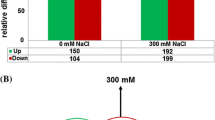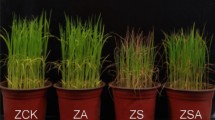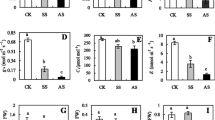Abstract
Forty-day-old Atriplex halimus seedlings were treated with either NaCl (50, 300 and 550 mM) for the subsequent 30 days or PEG for the following 3, 6 and 10 days. Shoot fresh and dry weights were significantly increased by 50 mM NaCl; nevertheless, the other concentrations had no effect. However, the growth was reduced by drought only after 10 days. Meanwhile, Na+ was accumulated in treated plants; the magnitude of accumulation was highest with high NaCl concentration or PEG for 10 days. The metabolite profiles showed discrimination particularly up-regulation of the amino acids proline, valine, isoleucine, and methionine. Moreover, the macro analysis revealed that NaCl- and PEG-treated plants shared 10 % of the metabolites in the positive mode, however, 87 % were unique to NaCl and 46 % were unique to PEG whereas in the negative mode, 8 % were in share while 90 or 53 % were restricted to NaCl or PEG, respectively. Additionally, sucrose in particular was significantly increased up to threefold and fivefold by 300 and 550 mM NaCl, respectively and up to 2.5-fold by drought for 10 days, nevertheless, the other sugar fractions remained largely unchanged. Also, proline was significantly increased by only the high NaCl concentrations and the long-term drought, nonetheless, the other treatments led, if any, to decreases. These results conclude that NaCl affects the metabolite profiles more than PEG and these metabolites might contribute to osmotic adjustments to act as osmoprotectants rather than osmolytes. These changes of metabolomics might function in many resistance and stress responses.







Similar content being viewed by others
References
Ahuja I, de Vos R, Bone AM, Hall RD (2010) Plant molecular stress responses face climate change. Trends Plant Sci 15:664–674
Ashraf M, Foolad MR (2007) Roles of glycine betaine and proline in improving plant abiotic stress resistance. Environ Exp Bot 59:206–216
Bajji M, Kinet JM, Lutts S (1998) Salt stress effects on roots and leaves of Atriplexhalimus L. and their corresponding callus cultures. Plant Sci 137:131–142
Barbier-Brygoo H, Joyard J (2004) Focus on plant proteomics. Plant Physiol Biochem 12:913–917
Bates LE (1973) Rapid determination of free proline for water stress studies. Plant Soil 39:205–207
Ben Hassine A, Ghanem ME, Bouzid S, Lutts S (2009) An inland and a coastal population of the Mediterranean xero-halophyte species Atriplex halimus L. differ in their ability to accumulate proline and glycinebetaine in response to salinity and water stress. J Exp Bot 59:1315–1326
Ben Salah I, Slatni T, Gruber M, Messedi D, Gandour M, Benzarti M, Haouala R, Zribi K, Ben Hamed K, Perez-Alfocea F, Abdelly C (2011) Relationship between symbiotic nitrogen fixation, sucrose synthesis and anti-oxidant activities in source leaves of two Medicago ciliaris lines cultivated under salt stress. Environ Exp Bot 70:166–173
Bino RJ, Hall RD, Fiehn O, Kopka J, Saito K, Draper J, Nikolau BJ, Mendes P, Roessner-Tunali U, Beale MH, Trethewey RN, Lange BM, Wurtele ES, Sumner LW (2004) Potential of metabolomics as a functional genomics tool. Trends Plant Sci 9:418–425
Bradley PM, Morris JT (1991) Relative importance of ion exclusion, secretion and accumulation in Spartina alterniflora Loisel. J Exp Bot 42:1525–1532
Cramer G, Ergul A, Grimplet J, Tillett R, Tattersall E, Bohlman M, Vincent D, Sonderegger J, Evans J, Osborne C, Quilici D, Schlauch K, Schooley D, Cushman J (2007) Water and salinity stress in grapevines: early and late changes in transcript and metabolite profiles. Funct Integr Genomics 7:111–134
Dao TT, Puig RC, Kim HK, Erkelens C, Lefeber AW, Linthorst HJ, Choi YH, Verpoorte R (2009) Effect of benzothiadiazole on the metabolome of Arabidopsis thaliana. Plant Physiol Biochem 47:146–152
Debez A, Chaıbi W, Bouzid S (2003) Physiological responses and structural modifications in Atriplex halimus L. plants exposed to salinity. In: Lieth H, Moschenko M (eds) Cash crop halophytes: recent studies: 10 years after the Al Ain meeting. Kluwer, Dordrecht, pp 19–30
Fiehn O, Weckwerth W (2003) Deciphering metabolic networks. Eur J Biochem 270:579–588
Gagneul D, Ainouche A, Duhaze C, Lugan R, Lahrer FR, Bouchereau A (2007) A reassessment of the function of the so-called compatible solutes in the halophytic Plumbginaceae Limonium latifolium. Plant Physiol 144:1598–1611
Gao XP, Pan QH, Li MJ, Zhang LY, Wang XF, Shen YY, Lu YF, Chen SW, Liang Z, Zhang DP (2004) Abscisic acid is involved in the water-stress-induced betaine accumulation in pear leaves. Plant Cell Physiol 45:742–750
Glenn EP, Brown JJ (1998) Effects of soil salt levels on the growth and water use efficiency of Atriplex canescens (Chenopodiaceae) varieties in drying soil. Am J Bot 85:10–16
Gong Q, Li P, Ma S, Rupassara SI, Bohnert H (2005) Salinity stress adaptation competence in the exptremophile Thellungiella halophila in comparison with its relative Arabidopsis thaliana. Plant Physiol 44:826–839
Hall R, Beale M, Fiehn O, Hardy N, Sumner L, Bino R (2002) Plant metabolomics: the missing link in functional genomics strategies. Plant Cell 14:1437–1440
Hansen EH, Munns DN (1988) Effect of CaSO4 and NaCl on mineral content of Leucaena leucocephala. Plant Soil 7:101–105
Hare PD, Cress WA (1997) Metabolic implications of stress-induced proline accumulation in plants. Plant Growth Regul 21:79–102
Hare PD, Cress WA, Staden JV (1998) Dissecting the roles of osmolytes accumulation during stress. Plant, Cell Environ 21:535–553
Iyer S, Caplan A (1998) Products of proline catabolism can induce osmotically regulated genes in rice. Plant Physiol 116:203–211
Jasiniski M, Kachlicki P, Rodziewicz P, Figlerowicz M, Stobiecki M (2009) Changes in the profile of flavonoid accumulation in Medicago truncatula leaves during infection with fungal pathogen Phoma medicaginis. Plant Physiol Biochem 47:847–853
Kavi Kishore P, Sangam S, Amrutha R, Laxmi P, Naidu K, Rao K, Rao S, Reddy K, Theriappan P, Sreenivasulu N (2005) Regulation of proline biosynthesis, degradation, uptake and transport in higher plants: its implications in plant growth and abiotic stress tolerance. Curr Sci 88:424–438
Kefu Z, Hai F, San Z, Jie S (2003) Study on the salt and drought tolerance of Suaeda salsa and Kalanchoe claigremontiana under iso-osmotic salt and water stress. Plant Sci 165:837–844
Khan M, Ungar I, Showalter A (2000) Effects of salinity on growth, water relations and ion accumulation of the subtropical perennial halophyte, Atriplex griffithii var. stocksii. Ann Bot 85:225–232
Kim JK, Bamba T, Harada K, Fukusaki E, Kobayashi A (2007) Time-course metabolic profiling in Arabidopsis thaliana cell cultures after salt stress treatment. J Exp Bot 58:415–424
Kozlowski TT, Pallardy SG (2002) Acclimation and adaptive responses of woody plants to environmental stresses. Bot Rev 68:270–334
Larher FR, Lugan R, Gagneul D, Guyot S, Monnier C, Lespinasse Y, Bouchereau A (2009) A reassessment of the prevalent organic solutes constitutively accumulated and potentially involved in osmotic adjustment in pear leaves. Environ Exp Bot 66:230–241
Louis P, Galinski EA (1997) Characterization of genes for the biosynthesis of compatible solute ectoine from Marinococcus halophilus and osmoregulated expression in E.coli. Microbiol 143:1141–1149
Low NH, McLaughlin M, Hofsommer H, Hammond DA (1999) Capillary gas chromatographic detection of invert sugar in heated, adulterated, and adulterated and heated apple juice concentrates employing the equilibrium method. J Agric Food Chem 47:4261–4266
Martinez JP, Ledent JF, Bajji M, Kinet JM, Lutts S (2003) Effect of water stress on growth, Na and K accumulation and water use efficiency in relation to osmotic adjustment in two populations of Atriplex halimus L. Plant Growth Regul 41:63–73
Martinez JP, Kinet JM, Bajji M, Lutts S (2005) NaCl alleviates polyethylene glycol-induced water stress in the halophyte species Atriplex halimus L. J Exp Bot 56:2421–2431
Munns R (2002) Comparative physiology of salt andwater stress. Plant, Cell Environ 25:239–250
Munns R (2005) Genes and salt tolerance: bringing them together. New Phytol 167:645–663
Oliver D, Nikolau B, Wurtele ES (2002) Functional genomics: high throughput mRNA, protein, and metabolite analyses. Metab Eng 4:98–108
Overy SA, Walker HJ, Malone S, Howard TP, Baxter CJ, Sweetlove LJ, Hill SA, Quick WP (2005) Application of metabolite profiling to the identification of traits in a population of tomato introgression lines. J Exp Bot 56:287–296
Rhodes D, Nadolska-Orczyk A, Rich PJ (2002) Salinity, osmolytes and compatible solutes. In: Laüchli A, Lüttge U (eds) Salinity: environment–plant–molecules. Kluwer, The Netherlands, pp 181–204
Sanchez DH, Siahpoosh MR, Roessner U, Udvardi M, Kopk J (2008) Plant metabolomics reveals conserved and divergent metabolic responses to salinity. Physiol Plant 132:209–219
Schauer N, Fernie AR (2006) Plant metabolomics: towards biological function and mechanism. Trends Plant Sci 11:508–516
Silveira JA, Araujo SA, Lima GP, Viegas RA (2009) Roots and leaves display contrasting osmotic adjustment mechanisms in response to NaCl-salinity in Atriplex nummularia. Environ Exp Bot 66:1–8
Stitt M (1990) Fructose 2,6-bisphosphate. In: Lea PJ (ed) Methods in plant biochemistry. Academic Press, London, pp 87–92
Sweetlove LJ, Last RL, Fernie AR (2003) Predictive metabolic engineering: a goal for systems biology. Plant Physiol 132:420–425
Zhu JK (2001) Plant salt tolerance. Trends Plant Sci 6:66–71
Author information
Authors and Affiliations
Corresponding author
Rights and permissions
About this article
Cite this article
Nemat Alla, M.M., Khedr, AH.A., Serag, M.M. et al. Regulation of metabolomics in Atriplex halimus growth under salt and drought stress. Plant Growth Regul 67, 281–304 (2012). https://doi.org/10.1007/s10725-012-9687-1
Received:
Accepted:
Published:
Issue Date:
DOI: https://doi.org/10.1007/s10725-012-9687-1




